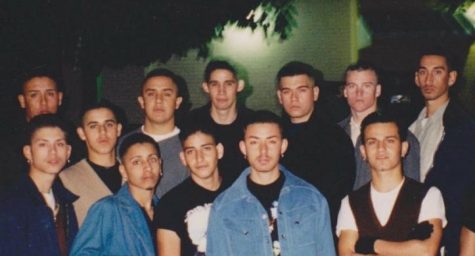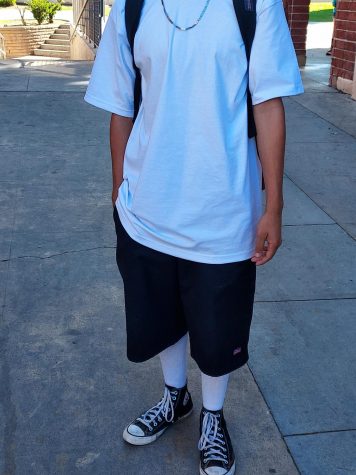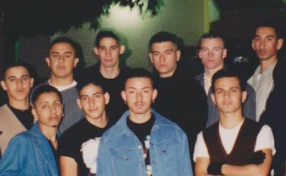Sophomore says dress code is racist
December 10, 2021
Reading the school dress code made me do a double-take.
Prohibited items include “shorts worn below the knee with socks up to the pant line” and “dramatically oversized button-down shirts, white t-shirts, or polo shirts that have been modified with ironed-on creases or pleats on the front or back.”
Wait a minute. What?

90’s Latino and African American hip-hop culture was all about baggy clothes, long white socks, with your chain and bandana. My dad’s whole friend group each had their own initialized belt buckles. They might have gotten in trouble a few times because of tagging, but they were by no means gangsters.
Basically my own father would have a dress code violation if he were to walk on campus.
Bottom line is that the language of the current dress code is undeniably discriminatory towards people of color. But I was surprised that the school didn’t try to tip-toe around it. They just flat out insinuate that if you wear these kinds of clothes, you are prone to violence.
Over the years, police officers have helped the school create a list of stuff that might be gang related. In the 1980s and 1990s, clothing with Raiders, Kings or Dodgers logos were banned. Today police officials claim that a “blanket” policy is better so students don’t feel discriminated against. Instead of saying you can’t wear Raiders, they just say, “No hats.”
Although I appreciate that the police are trying to keep us safe, students deserve better. I know that a Ban Everything policy is easier to enforce, but a Ban Everything policy isn’t fair, especially when the dress code specifically targets the culture of students who comprise 65% of our school. Students have a right to wear clothing that reflects who they are. And if wearing clothing from their own fathers’ closets makes them happy, they should be allowed to do just that.
Some argue, however, that we really do need to protect ourselves from gangs. True. But even the police officers we spoke to admit that they don’t assume someone is a gang member just because they are wearing baggy clothes and long socks. Sgt. Perry Thayer from the Fullerton Police Department said he needs concrete evidence to classify someone as a gang member and it has to be “more than just a hunch.”
“If the person in question is associating with thoroughly documented gang members and he’s dressed like them, chances are this person is either a gang member or is attempting to join a gang,” Thayer said. “However, if it’s just some kid who thinks it’s cool to dress like that and he has no gang ties at all then we’ll investigate. When we talk to this person and ask the right questions and we see that they’re not gang members then we don’t document them as one.”
If the police take time to actually talk to people, why aren’t the school officials giving students the benefit of the doubt, too? Instead of trying to control every teen fashion choice, the adults need to get to know—really know—the students. Who are their parents? What are their goals? Do they need any help?

I understand that the school officials are scared. They think if they relax the dress code, absolute chaos will erupt. Students will start fighting. The quad will be a war zone.
However, times have changed.
The Tribe Tribune interviewed Chicano Studies professor Gabriela Nuñez from Cal State Fullerton. She agrees that the dress code is outdated.
“I think that those specific dress codes are connected to thoughts about criminality, which is related to youth of color, historically. I just think it seems a little dated,” Nuñez said. “It seems like these details like baggy and saggy pants are so mainstream. I was sitting down with my very fashionable nephew who’s in high school and I asked him if there are any particular groups of people at school who wear baggy pants at school and he said that everybody wears baggy pants.”
If school officials eliminate much of the so-called gang-related language from the dress code, it would send a message to hispanic students that they respect them. I’m not saying that everyone will be an angel, but it isn’t fair if 1% of the student body dictates what the other 99% can wear. Give us a chance. Having a student wear long white socks with shorts isn’t a crime. If people start going wild then change it back. But if the school puts in place stricter policies, the most important thing is to explain why we need the restrictions.
With all these interviews with police and school officials, the thing that bothered me most was the condescending attitude. Being repeatedly told that things were bigger than me was extremely frustrating, especially when the whole reason we were talking to them was to learn the reasons behind the dress code. They’re targeting our bodies and what we wear and we have a right to know why. Someone needs to explain to students why “bandanas” and “chains” are seen as “provoking violence” and “disrupting school operations”.
Almost all the officials said something along the lines of students are here to learn not to show off their outfits. They’re right, students are here to learn, but how are they supposed to learn if they are being pulled aside and constantly dress coded? How are we supposed to respect the school rules, when the rules themselves are disrespectful?

